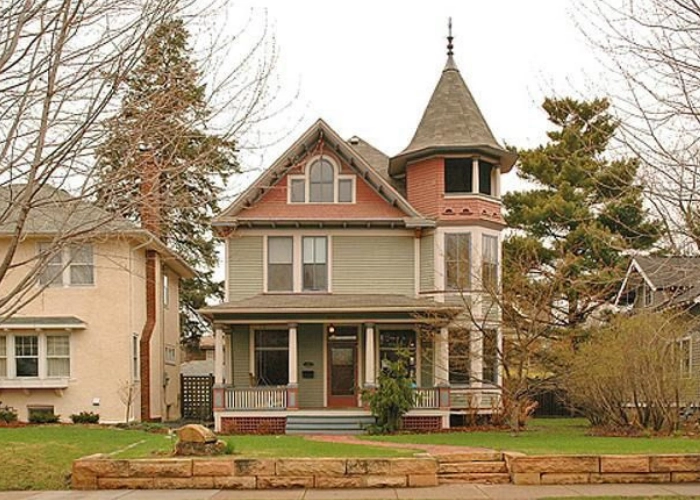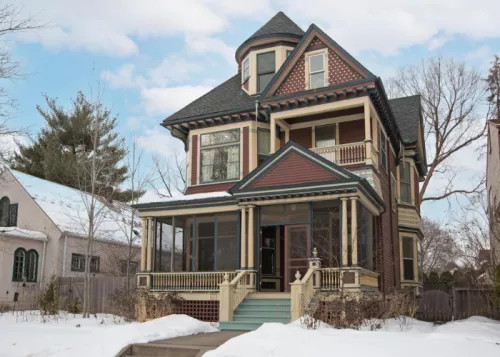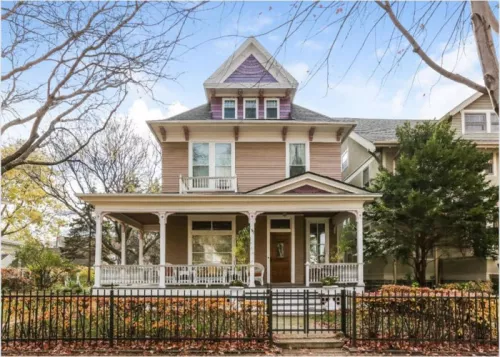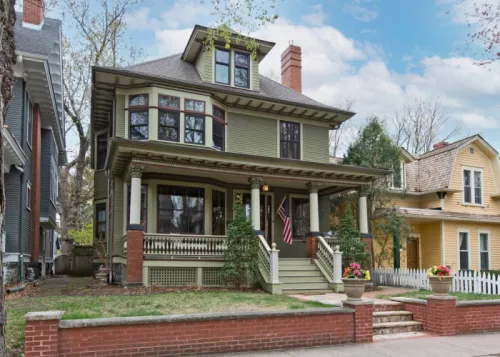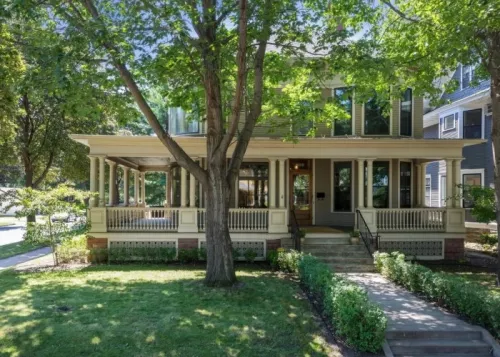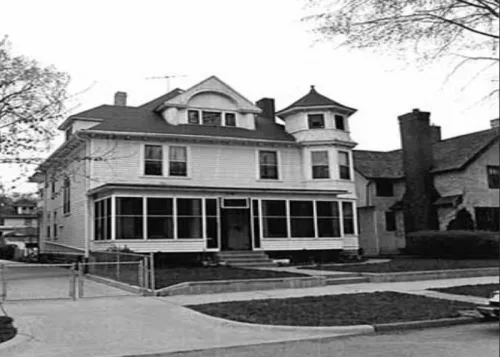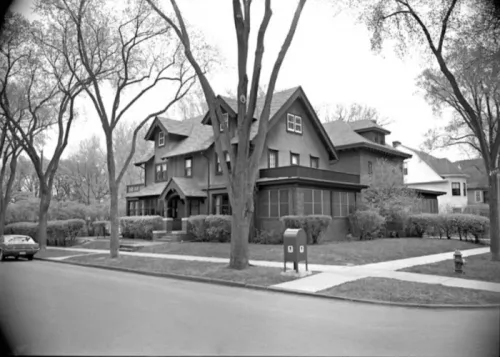Share what you know,
and discover more.
Share what you know,
and discover more.
Jun 01, 2011
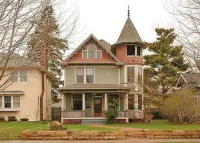
-

- Dave D
History of 839 Fairmount Avenue, Saint Paul, MN, USA
Oscar Hallam House; Built-in 1905 (1890 according to Ramsey County property tax records;) Emil Bostrum, architect. This structure is listed on the National Register of Historic Places as part of the historic Hill District. 1894, 1896, and 1898 city directories indicate that Mr. and Mrs. Oscar Hallam and Mrs. C. F. Lott all resided at this address. Oscar Hallam (1865-1945,) the son of Joseph Hallam and Mary Wood Hallam, was born in Linden, Wisconsin, attended Wisconsin country district schools, graduated from the Dodgeville, Wisconsin, High School, graduated from the University of Wisconsin in 1887, graduated from the University of Wisconsin Law School in 1889, moved to Minnesota in 1889, married Edith Lott ( -1942) in St. Paul in 1892, was admitted to the practice of law in Minnesota in 1889, practiced law from 1889 until 1905, was a jurist, was a judge in the Second Judicial District (Ramsey County) from 1905 until 1912, was an Associate Justice on the Minnesota Supreme Court from 1913 until 1923, was a faculty member of the St. Paul College of Law from 1901 until 1945, was the dean of the St. Paul College of Law from 1919 until 1941, was the chair of the Minnesota Crime Commission in 1926, was chief counsel of the Minneapolis-St. Paul Sanitary District from 1933 until 1945, served as president of the Ramsey County Bar Association, was a member of the Minnesota Bar Association, was a member of the American Bar Association, chaired the board of governors of the Twin City Unit of the Shriners Hospital for Crippled Children, chaired the 4-Minute Men of Minnesota in 1918, was the president of the Navy League of Minnesota, was a member of the board of the St. Paul Council of the Campfire Girls, was a Republican, was a Congregationalist, was a Mason, was an Odd Fellow, was a member of the Kiwanis Club, was a member of the St. Paul Commercial Club, was a member of the Minnesota Club, was a member of the St. Paul Town & Country Club, was a member of the St. Paul Athletic Club, and officed at the Ramsey County Court House. In 1918, Oscar Hallam gave a speech to the Minnesota State Bar Association entitled "German Notions of International Law" that was published by the America First Association. Judge Oscar Hallam headed a special American Bar Association committee to examine the pretrial publicity attending the trial of Bruno Richard Hauptmann, the convicted kidnapper and murderer of the son of Charles Lindbergh. In 1923, Oscar Hallam was a Republican candidate for the U. S. Senate seat previously held by Knute Nelson but was defeated by Governor J. A. O. Preus in the primary election. Also in 1923, Oscar Hallam was a member of the board of the 60 bed Twin Cities Masonic Hospital. In 1926, 1927, and 1930, Oscar Hallam was the chair of the Minnesota Commission on Criminal Apprehension, the second crime commission in state history, and was appointed, with 23 other members, by Governor Theodore Christianson in January 1926. Oscar Hallam also was dean of the St. Paul College of Law after his service as a judge. Hallam wrote Bloomfield and Number Five: The American Way of Life in a Wisconsin Rural Community in the Seventies as Seen by a Small Boy, his reminiscences focusing on his farm boyhood near Dodgeville, Wisconsin, in the 1870's. Hallam also was the author of "Early Courts and Lawyers" in The Yale Law Journal, Vol. 25, No. 5 (1916,) of "Some Object Lessons on Publicity in Criminal Trials" in 24 Minn. L. Rev. 453, 465 (1940,) of "Dealing with Crime-Some Urgent Needs" in Annals of the American Academy of Political and Social Science, Vol. 125 (1926,) and of "The Essentials. Minnesota's Experiment" in Journal of the American Institute of Criminal Law and Criminology, Vol. 18, No. 3 (1927.) The 1891 city directory indicates that Oscar Hallam was associated with the law firm of Lewis & Hallam and resided at 234 Arundel. Oakland Cemetery Association records indicate that Cornelia F. Lott (1841-1897,) who died of uterine cancer, resided at this address in 1897. The 1900 and 1902 city directories indicate that Mr. and Mrs. Oscar Hallam resided at this address. .The 1910-1911 Directory of the University of Minnesota indicates that Dr. J. T. Christison, a faculty member, resided at this address and officed at the Endicott Arcade. The 1916 University of Minnesota Alumni Directory indicates that James Trent Christison resided at this address. The 1918 and 1924 city directories indicate that Dr. and Mrs. J. T. Christison resided at this address. The 1930 city directory indicates that Alex A. McKechnie, the secretary of the St. Paul Union Stockyards Company, and his wife, Ruth S. McKechnie, resided at this address.
History of 839 Fairmount Avenue, Saint Paul, MN, USA
Oscar Hallam House; Built-in 1905 (1890 according to Ramsey County property tax records;) Emil Bostrum, architect. This structure is listed on the National Register of Historic Places as part of the historic Hill District. 1894, 1896, and 1898 city directories indicate that Mr. and Mrs. Oscar Hallam and Mrs. C. F. Lott all resided at this address. Oscar Hallam (1865-1945,) the son of Joseph Hallam and Mary Wood Hallam, was born in Linden, Wisconsin, attended Wisconsin country district schools, graduated from the Dodgeville, Wisconsin, High School, graduated from the University of Wisconsin in 1887, graduated from the University of Wisconsin Law School in 1889, moved to Minnesota in 1889, married Edith Lott ( -1942) in St. Paul in 1892, was admitted to the practice of law in Minnesota in 1889, practiced law from 1889 until 1905, was a jurist, was a judge in the Second Judicial District (Ramsey County) from 1905 until 1912, was an Associate Justice on the Minnesota Supreme Court from 1913 until 1923, was a faculty member of the St. Paul College of Law from 1901 until 1945, was the dean of the St. Paul College of Law from 1919 until 1941, was the chair of the Minnesota Crime Commission in 1926, was chief counsel of the Minneapolis-St. Paul Sanitary District from 1933 until 1945, served as president of the Ramsey County Bar Association, was a member of the Minnesota Bar Association, was a member of the American Bar Association, chaired the board of governors of the Twin City Unit of the Shriners Hospital for Crippled Children, chaired the 4-Minute Men of Minnesota in 1918, was the president of the Navy League of Minnesota, was a member of the board of the St. Paul Council of the Campfire Girls, was a Republican, was a Congregationalist, was a Mason, was an Odd Fellow, was a member of the Kiwanis Club, was a member of the St. Paul Commercial Club, was a member of the Minnesota Club, was a member of the St. Paul Town & Country Club, was a member of the St. Paul Athletic Club, and officed at the Ramsey County Court House. In 1918, Oscar Hallam gave a speech to the Minnesota State Bar Association entitled "German Notions of International Law" that was published by the America First Association. Judge Oscar Hallam headed a special American Bar Association committee to examine the pretrial publicity attending the trial of Bruno Richard Hauptmann, the convicted kidnapper and murderer of the son of Charles Lindbergh. In 1923, Oscar Hallam was a Republican candidate for the U. S. Senate seat previously held by Knute Nelson but was defeated by Governor J. A. O. Preus in the primary election. Also in 1923, Oscar Hallam was a member of the board of the 60 bed Twin Cities Masonic Hospital. In 1926, 1927, and 1930, Oscar Hallam was the chair of the Minnesota Commission on Criminal Apprehension, the second crime commission in state history, and was appointed, with 23 other members, by Governor Theodore Christianson in January 1926. Oscar Hallam also was dean of the St. Paul College of Law after his service as a judge. Hallam wrote Bloomfield and Number Five: The American Way of Life in a Wisconsin Rural Community in the Seventies as Seen by a Small Boy, his reminiscences focusing on his farm boyhood near Dodgeville, Wisconsin, in the 1870's. Hallam also was the author of "Early Courts and Lawyers" in The Yale Law Journal, Vol. 25, No. 5 (1916,) of "Some Object Lessons on Publicity in Criminal Trials" in 24 Minn. L. Rev. 453, 465 (1940,) of "Dealing with Crime-Some Urgent Needs" in Annals of the American Academy of Political and Social Science, Vol. 125 (1926,) and of "The Essentials. Minnesota's Experiment" in Journal of the American Institute of Criminal Law and Criminology, Vol. 18, No. 3 (1927.) The 1891 city directory indicates that Oscar Hallam was associated with the law firm of Lewis & Hallam and resided at 234 Arundel. Oakland Cemetery Association records indicate that Cornelia F. Lott (1841-1897,) who died of uterine cancer, resided at this address in 1897. The 1900 and 1902 city directories indicate that Mr. and Mrs. Oscar Hallam resided at this address. .The 1910-1911 Directory of the University of Minnesota indicates that Dr. J. T. Christison, a faculty member, resided at this address and officed at the Endicott Arcade. The 1916 University of Minnesota Alumni Directory indicates that James Trent Christison resided at this address. The 1918 and 1924 city directories indicate that Dr. and Mrs. J. T. Christison resided at this address. The 1930 city directory indicates that Alex A. McKechnie, the secretary of the St. Paul Union Stockyards Company, and his wife, Ruth S. McKechnie, resided at this address.
Jun 01, 2011
History of 839 Fairmount Avenue, Saint Paul, MN, USA
Oscar Hallam House; Built-in 1905 (1890 according to Ramsey County property tax records;) Emil Bostrum, architect.This structure is listed on the National Register of Historic Places as part of the historic Hill District. 1894, 1896, and 1898 city directories indicate that Mr. and Mrs. Oscar Hallam and Mrs. C. F. Lott all resided at this address.
Oscar Hallam (1865-1945,) the son of Joseph Hallam and Mary Wood Hallam, was born in Linden, Wisconsin, attended Wisconsin country district schools, graduated from the Dodgeville, Wisconsin, High School, graduated from the University of Wisconsin in 1887, graduated from the University of Wisconsin Law School in 1889, moved to Minnesota in 1889, married Edith Lott ( -1942) in St. Paul in 1892, was admitted to the practice of law in Minnesota in 1889, practiced law from 1889 until 1905, was a jurist, was a judge in the Second Judicial District (Ramsey County) from 1905 until 1912, was an Associate Justice on the Minnesota Supreme Court from 1913 until 1923, was a faculty member of the St. Paul College of Law from 1901 until 1945, was the dean of the St. Paul College of Law from 1919 until 1941, was the chair of the Minnesota Crime Commission in 1926, was chief counsel of the Minneapolis-St. Paul Sanitary District from 1933 until 1945, served as president of the Ramsey County Bar Association, was a member of the Minnesota Bar Association, was a member of the American Bar Association, chaired the board of governors of the Twin City Unit of the Shriners Hospital for Crippled Children, chaired the 4-Minute Men of Minnesota in 1918, was the president of the Navy League of Minnesota, was a member of the board of the St. Paul Council of the Campfire Girls, was a Republican, was a Congregationalist, was a Mason, was an Odd Fellow, was a member of the Kiwanis Club, was a member of the St. Paul Commercial Club, was a member of the Minnesota Club, was a member of the St. Paul Town & Country Club, was a member of the St. Paul Athletic Club, and officed at the Ramsey County Court House.
In 1918, Oscar Hallam gave a speech to the Minnesota State Bar Association entitled "German Notions of International Law" that was published by the America First Association. Judge Oscar Hallam headed a special American Bar Association committee to examine the pretrial publicity attending the trial of Bruno Richard Hauptmann, the convicted kidnapper and murderer of the son of Charles Lindbergh. In 1923, Oscar Hallam was a Republican candidate for the U. S. Senate seat previously held by Knute Nelson but was defeated by Governor J. A. O. Preus in the primary election.
Also in 1923, Oscar Hallam was a member of the board of the 60 bed Twin Cities Masonic Hospital. In 1926, 1927, and 1930, Oscar Hallam was the chair of the Minnesota Commission on Criminal Apprehension, the second crime commission in state history, and was appointed, with 23 other members, by Governor Theodore Christianson in January 1926. Oscar Hallam also was dean of the St. Paul College of Law after his service as a judge. Hallam wrote Bloomfield and Number Five: The American Way of Life in a Wisconsin Rural Community in the Seventies as Seen by a Small Boy, his reminiscences focusing on his farm boyhood near Dodgeville, Wisconsin, in the 1870's. Hallam also was the author of "Early Courts and Lawyers" in The Yale Law Journal, Vol. 25, No. 5 (1916,) of "Some Object Lessons on Publicity in Criminal Trials" in 24 Minn. L. Rev. 453, 465 (1940,) of "Dealing with Crime-Some Urgent Needs" in Annals of the American Academy of Political and Social Science, Vol. 125 (1926,) and of "The Essentials. Minnesota's Experiment" in Journal of the American Institute of Criminal Law and Criminology, Vol. 18, No. 3 (1927.)
The 1891 city directory indicates that Oscar Hallam was associated with the law firm of Lewis & Hallam and resided at 234 Arundel.
Oakland Cemetery Association records indicate that Cornelia F. Lott (1841-1897,) who died of uterine cancer, resided at this address in 1897. The 1900 and 1902 city directories indicate that Mr. and Mrs. Oscar Hallam resided at this address.
.The 1910-1911 Directory of the University of Minnesota indicates that Dr. J. T. Christison, a faculty member, resided at this address and officed at the Endicott Arcade. The 1916 University of Minnesota Alumni Directory indicates that James Trent Christison resided at this address.
The 1918 and 1924 city directories indicate that Dr. and Mrs. J. T. Christison resided at this address. The 1930 city directory indicates that Alex A. McKechnie, the secretary of the St. Paul Union Stockyards Company, and his wife, Ruth S. McKechnie, resided at this address.
Posted Date
Feb 07, 2022
Historical Record Date
Jun 01, 2011
Source Name
Thursday Night Hikes
Delete Story
Are you sure you want to delete this story?
